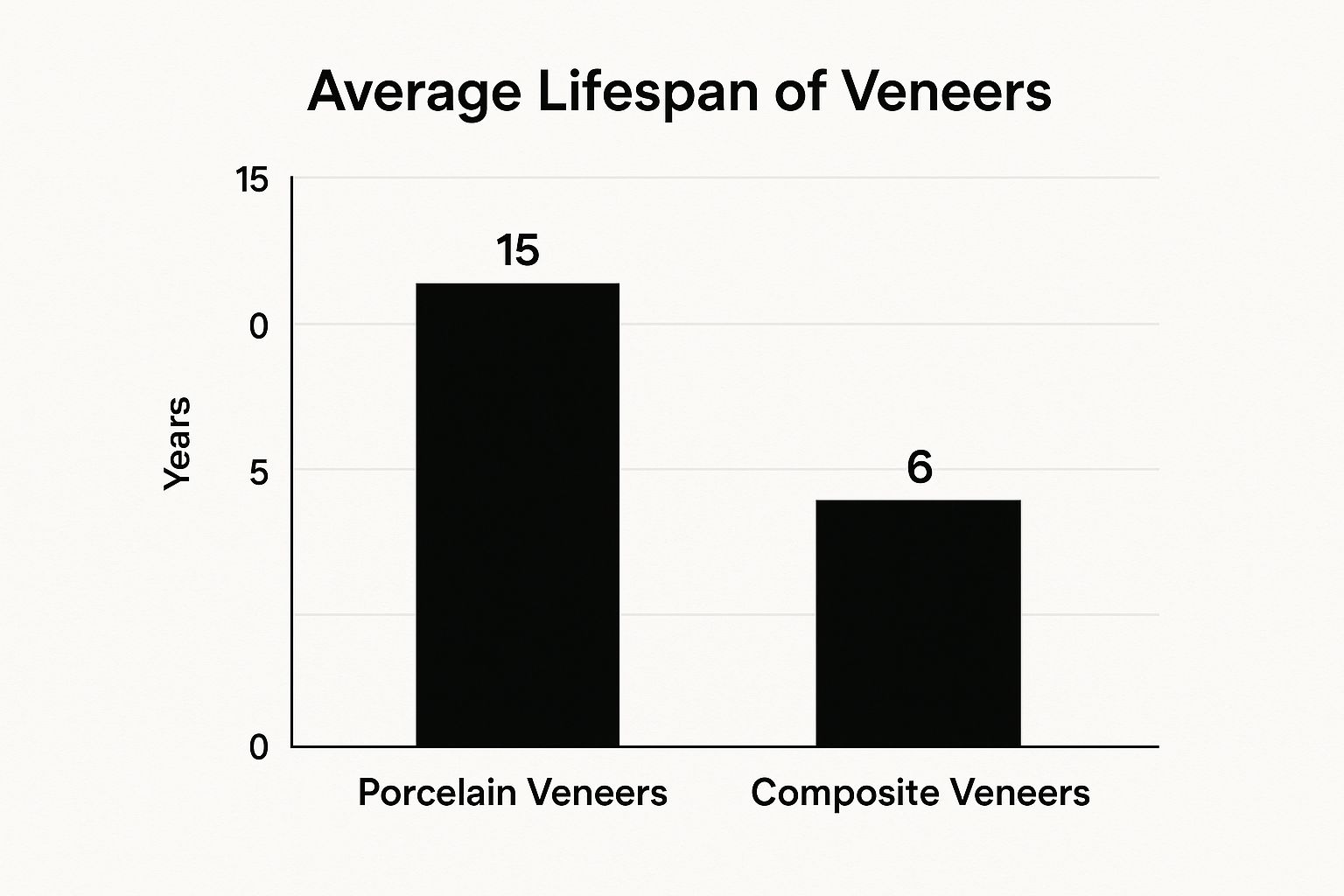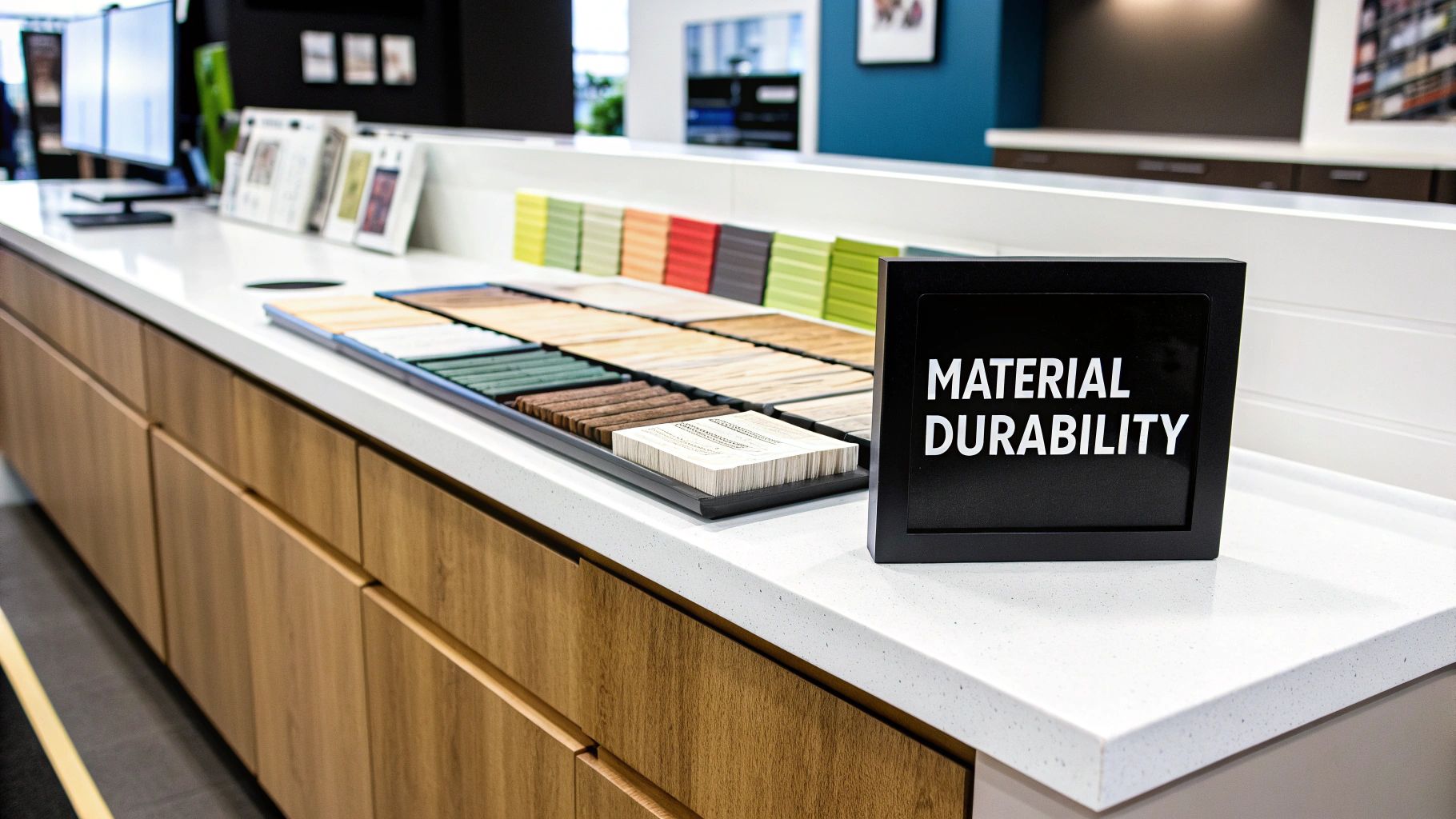How Long Do Veneers Last? An Actionable Guide
- Caterina Rutter
- Oct 21
- 11 min read
Thinking about veneers raises a critical question: how long do they actually last? Understanding the answer is key to making a smart investment in your smile.
The lifespan isn't a single number—it depends entirely on the material. As a rule of thumb, porcelain veneers are the long-term champions, typically lasting 10 to 20 years. In contrast, composite veneers offer a shorter lifespan, usually around 5 to 7 years.
Knowing this difference helps you plan not just for the initial procedure, but for the future of your smile.
A First Look at Veneer Longevity
Choosing between veneer types is like selecting a kitchen countertop. Porcelain veneers are the quartz or granite—incredibly durable, stain-resistant, and engineered to look phenomenal for decades. Composite veneers are more like a high-end laminate; they provide a beautiful, budget-friendly result upfront but lack the same resilience against daily use.
This comparison isn't just about cost—it's about understanding the maintenance and long-term commitment your choice requires.
Porcelain vs. Composite Veneers
To truly grasp their lifespan, you need to know what they're made of and how they're applied. This knowledge empowers you to ask the right questions during your consultation.
Porcelain Veneers: These are thin, custom-crafted shells of a robust ceramic that excels at resisting stains from coffee, tea, or wine. A dental lab fabricates them for a perfect fit, which means the process requires at least two appointments.
Composite Veneers: Made from a tooth-colored resin, your dentist applies and sculpts these directly onto your teeth, often in a single visit. While they look great, they are more susceptible to staining and chipping than porcelain.
Actionable Insight: If you're looking for a low-maintenance, "set-it-and-forget-it" solution that will hold its color and strength for over a decade, porcelain is your best bet. If a lower upfront cost and a quicker process are your priorities, composite is a viable option, but be prepared for more frequent touch-ups or replacements.
Here’s a clear, side-by-side comparison to help you weigh your options.
Veneer Lifespan at a Glance
This table breaks down the key differences so you can make an informed decision.
Veneer Type | Average Lifespan | Pros | Cons |
|---|---|---|---|
Porcelain | 10 - 20 years | Extremely durable, stain-resistant, natural-looking | Higher upfront cost, requires multiple visits |
Composite | 5 - 7 years | Lower cost, single-visit procedure, easily repaired | More prone to staining and chipping, shorter lifespan |
The takeaway is clear: while composites have their place, porcelain offers a significantly longer-lasting solution, making it a better value over the long term for many patients.
This infographic provides a great visual summary of what to expect.

The data confirms the durability gap. Porcelain veneers don't just last a bit longer—they often last more than twice as long.
Longevity studies consistently show that about 95% of porcelain veneers remain in excellent condition after a decade, with success rates staying high well past the 15-year mark. This proven track record is why they are considered a reliable, long-term investment. To learn more, you can explore insights about veneer durability from comprehensive reviews on genesispub.org.
Why Material Choice Is Everything for Veneer Durability

When it comes to how long veneers last, one factor outweighs all others: the material. Not all veneers are created equal, and their composition is the single biggest predictor of their strength, aesthetic stability, and overall lifespan.
Porcelain veneers are the gold standard for good reason. Crafted from high-grade ceramic, they are incredibly strong, non-porous, and brilliantly resistant to stains. This robust nature allows them to withstand the daily forces of biting and chewing for years, all while maintaining their bright, natural-looking hue.
Composite resin veneers are a versatile and effective alternative. However, the plastic-based material is more porous and less tough than ceramic, leaving it more vulnerable to staining and chipping. This fundamental material difference directly explains their shorter lifespan.
A Closer Look at Porcelain's Staying Power
What makes porcelain so resilient? It's all about its structure and fabrication process. Dental labs fire these veneers at extreme temperatures, creating a dense, glass-like shell that's unbelievably strong.
This process delivers key functional advantages:
Stain Resistance: The non-porous surface of porcelain prevents pigments from coffee, red wine, or berries from seeping in and causing discoloration. Your smile stays the same shade for years.
Natural Appearance: Porcelain has a translucent quality that expertly mimics how light reflects off natural tooth enamel, delivering an authentic-looking smile.
Superior Hardness: This material is extremely hard and resists wear and tear, protecting it from the micro-scratches that can dull a smile over time.
This powerful combination means that with proper care, your porcelain veneers can look as brilliant in year ten as they did on day one. Understanding these material differences is crucial as you explore different cosmetic dentistry procedures to achieve a gleaming smile.
The Next Generation: Advanced Ceramics Like Emax
Just when porcelain seemed to be the peak, advanced materials like Emax pushed durability even further. Emax veneers are made from lithium disilicate, a special type of ceramic renowned for even greater strength and resilience.
Actionable Insight: When discussing options with your dentist, ask specifically about advanced ceramics like Emax. Its monolithic structure—milled from a single, solid block—eliminates the weaker points found in layered porcelain, dramatically reducing the risk of chips or fractures.
The material you choose directly impacts your investment's longevity. While traditional porcelain veneers are highly durable, often lasting 10 to 15 years, it's not uncommon for advanced versions like Emax to last up to 20 years. Their superior tensile strength gives them this incredible staying power. Ultimately, knowing the difference between these materials prepares you to have a productive, informed conversation with your dentist about which option best fits your lifestyle, budget, and long-term smile goals.
Daily Habits That Impact Veneer Longevity

While your choice of material sets the baseline for your veneers' lifespan, how long they actually last is largely up to you. Your daily habits are the single biggest factor you can control. Small, seemingly harmless actions can accumulate over time, putting significant stress on your veneers and the bonding that holds them in place. Conversely, a few simple adjustments to your routine can dramatically extend their life.
Your Choices in the Kitchen Matter
What you eat—and more importantly, how you eat it—directly impacts your veneers. While porcelain is tough, it isn't indestructible. Consistently challenging it with extremely hard or sticky foods can test its limits.
Here are actionable habits to adopt:
Avoid Biting on Hard Objects: This is the golden rule. Stop chewing on ice, hard candy, popcorn kernels, or your fingernails. This habit creates focused pressure points that can easily chip or crack a veneer.
Chew with Your Back Teeth: When eating tough foods like crusty bread or steak, consciously use your molars for heavy-duty chewing. This simple shift minimizes the direct force on your front-facing veneers.
Limit Staining Agents (Especially for Composites): While porcelain resists stains well, composites are more susceptible. If you have composite veneers, moderating your intake of coffee, tea, red wine, and dark berries will help maintain their color. Rinsing with water after consumption can also help.
Unconscious Habits That Cause Damage
Sometimes, the greatest threats are the habits you're not even aware of. These actions can exert tremendous, repetitive force on your teeth, silently wearing down the veneer, the bonding agent, and your underlying tooth.
The most common culprit is bruxism—the chronic grinding and clenching of teeth, often during sleep. The constant pressure from bruxism can be incredibly destructive, leading to chips, fractures, or even causing a veneer to pop off. Many of these are just plain bad habits that could harm your teeth, but the risk is amplified with cosmetic restorations.
Another major issue is using your teeth as a tool.
Actionable Insight: Make a conscious effort to stop using your teeth to open packages, rip tape, or hold pins. Your teeth are designed for one purpose: chewing food. Using them for anything else is an invitation for an expensive, avoidable repair.
If you suspect you grind your teeth, a custom-fitted nightguard is an essential investment. It acts as a protective cushion, absorbing the grinding forces and shielding your veneers. This single appliance can add years to the life of your new smile.
A Practical Care Guide to Protect Your Investment
Think of your veneer care routine as a simple but powerful insurance policy. Your veneers need consistent, mindful care to reach their maximum lifespan. The good news is that it doesn't require a lot of effort—just a few smart habits integrated into your daily life can add years to their longevity, keeping them looking brilliant and feeling secure.
Building Your Daily Maintenance Routine
The foundation of long-lasting veneers is excellent oral hygiene. The goal is to keep your natural teeth and gums healthy while being gentle on the restorations. The bond holding your veneer is strongest when the surrounding environment is clean and healthy.
Here’s your daily action plan:
Brush Gently, but Thoroughly: Use a soft-bristled toothbrush and a non-abrasive toothpaste. Gritty whitening pastes can create micro-scratches on the veneer's surface, dulling its shine over time.
Floss Correctly: Flossing is non-negotiable. Carefully guide the floss between your teeth, curving it around the tooth at the gumline. Avoid snapping the floss down, as this can stress the veneer's delicate edge.
Rinse Smart: Add an alcohol-free, antiseptic mouthwash to your routine. It helps kill bacteria without drying out your mouth, which can compromise the bonding agent over time.
These steps are your first line of defense. For more ideas, our guide on tips to maintaining good dental health offers advice that applies to both natural teeth and veneers.
Essential Tools for Long-Term Protection
Beyond daily care, a few key items can make a significant difference in your veneers' longevity, especially if you have habits like teeth grinding.
Actionable Insight: If you grind or clench your teeth at night (bruxism), a custom-fitted nightguard is non-negotiable. It acts as a protective barrier, absorbing the immense force that would otherwise be directed at your veneers, preventing chips, cracks, or debonding while you sleep.
Of course, nothing replaces professional oversight. Regular dental check-ups allow your dentist to spot potential issues early and perform professional cleanings with specialized, veneer-safe equipment. Sticking to your hygiene schedule is one of the easiest ways to ensure your smile stays perfect for years.
To make it simple, follow this care checklist.
Daily, Weekly, and Yearly Veneer Care Checklist
Frequency | Action Item | Why It's Important |
|---|---|---|
Twice Daily | Brush with a soft-bristled brush and non-abrasive toothpaste. | Prevents plaque buildup and staining without scratching the veneers. |
Once Daily | Floss carefully around each veneer. | Removes plaque from between teeth where cavities can form. |
Once Daily | Rinse with an alcohol-free antiseptic mouthwash. | Kills bacteria and keeps gums healthy without weakening the bond. |
As Needed | Wear your custom-fitted nightguard (if you grind your teeth). | Protects veneers from the immense pressure of clenching and grinding. |
Every 6 Months | Schedule a professional dental cleaning and check-up. | Allows your dentist to perform a safe cleaning and spot issues early. |
Yearly | Discuss the condition of your veneers with your dentist. | Helps track their wear and plan for any future maintenance needs. |
Following this schedule gives you the best chance of keeping your veneers in pristine condition for their maximum lifespan.
Recognizing the Signs Your Veneers Need Replacement

Veneers are durable, but they don't last forever. Knowing what to look for is key to protecting your investment and the health of your underlying teeth. When you can spot early warning signs, you can be proactive, addressing small issues with your dentist before they become major problems.
Physical Damage to the Veneer
The most obvious sign of a problem is visible damage. Years of use can eventually cause wear. Make it a habit to examine your smile closely in the mirror and take note of any changes.
Here’s what to watch for:
Chips and Cracks: Even a tiny fracture can weaken the entire veneer and create a hiding spot for bacteria, which can lead to decay on the natural tooth.
Rough Edges: Run your tongue over your veneers. If you feel a new jagged or rough spot, it’s a clear sign of wear or a small chip that requires professional attention.
Noticeable Wear: After many years, the surface may lose its sheen and appear dull. This is particularly common for patients who grind their teeth.
Changes Around the Veneer
Sometimes, the issue isn't with the veneer itself but with the supporting gum and tooth. A restoration is only as strong as its foundation.
Actionable Insight: A major red flag is debonding. If a veneer feels loose or moves slightly when you touch it, the dental cement is failing. This requires an immediate call to your dentist to prevent it from falling off or being swallowed.
Another key sign is gum recession. If your gums pull back, they can expose the top edge of the veneer. This not only compromises the seamless look but also creates a ledge where plaque can accumulate, increasing your risk for cavities.
Aesthetic and Functional Concerns
Beyond physical damage, you might simply notice your veneers no longer look or feel right. Staining is a common issue, particularly with older composite veneers. If you see discoloration that cannot be polished away by your hygienist, it may be time for a replacement.
Veneer procedures have recently surged by 250%. While they have an excellent track record, issues like cracks or debonding can occur in about 7.2% of cases. However, when placed on healthy teeth, veneers boast a success rate of over 99%. You can learn more about these veneer statistics on impressionsdental.com.
Knowing these signs empowers you to take action and keep your smile healthy for as long as possible.
Your Questions About Veneer Durability, Answered
Even with all the facts, it’s normal to have specific questions about how veneers will impact your life. Here are clear, actionable answers to the most common concerns.
Do Veneers Ruin Your Natural Teeth?
This is a top concern, and the answer is no, provided the procedure is performed by a skilled, experienced dentist. To ensure a seamless fit, a very thin layer of enamel—typically less than 0.5 millimeters, about the thickness of a fingernail—is removed from the front of the tooth.
This step is irreversible, but it is what allows the veneer to sit flush with your gum line and look completely natural, not like a bulky addition. The underlying tooth remains healthy and whole, protected by the durable porcelain shell.
Can You Whiten Veneers?
This is a critical point to understand: veneer color is permanent. Porcelain is a non-porous ceramic, which is great for resisting stains but also means whitening treatments won't affect it. Bleaching gels cannot penetrate the material to alter its shade.
Actionable Insight: If you are considering whitening your teeth, do it before you get veneers. This allows us to create veneers that match your newly brightened smile, ensuring a beautiful, uniform look that will last for years.
What Should I Do If a Veneer Falls Off?
While uncommon, a veneer can occasionally come loose. If this happens, don't panic. Stay calm and follow these steps:
Secure the veneer. Carefully retrieve it and store it in a small, hard container like a pillbox to prevent loss or damage.
Call your dentist immediately. Explain what happened and schedule an appointment as soon as possible. Your underlying tooth may be sensitive without its protective covering.
Do not attempt a DIY fix. Never use superglue or any other household adhesive. These products are toxic and can permanently damage both the veneer and your tooth, making a professional reattachment impossible.
In most cases, if the veneer is intact, your dentist can simply clean and rebond it.
Is the Veneer Procedure Painful?
The procedure itself should not be painful. We use a local anesthetic to ensure the area is completely numb before beginning any work. You might feel some light pressure or hear the instruments, but you should not feel any pain.
After the anesthetic wears off, it's common to experience some mild sensitivity to hot and cold for a few days as your teeth adjust. This sensation typically fades quickly, leaving you with a smile that is both beautiful and comfortable.
Ready to explore how veneers can transform your smile with a team dedicated to your comfort and long-term results? At Beautiful Dentistry, we combine artistry with advanced technology to create smiles that are not only stunning but also built to last.


Comments